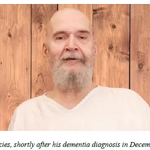
On August 19, 2025, the Utah Pardons Board denied Ralph Menzies’ petition for commutation, despite his worsening dementia, failing health, and evidence that his 1988 death sentence “was imposed in error” and “obtained using perjured testimony.” The Pardons Board was asked to commute his sentence to life without the possibility of parole (LWOP). According to reporting by the Utah News Dispatch, Utah’s Pardon Board has never granted clemency to a death-sentenced person.
“Ralph Menzies is a 67-year-old man with progressively worsening dementia. He’s tethered to an oxygen tank, uses a wheelchair, is confused and disoriented, and no longer understands why Utah is trying to kill him … This is reason enough to grant mercy.”
Attorneys for Mr. Menzies note he suffers from vascular dementia, a progressive terminal condition that means he no longer understands why the State of Utah is seeking to execute him. The August 13 – 14, 2025, Pardon Board hearing featured testimony by dueling medical professionals who gave strikingly different perspectives on Mr. Menzies’ mental faculties. Doctors for the defense stated Mr. Menzies’ vascular dementia meant that “his brain is wasting away,” while one doctor testifying for the state said he “found little evidence of cognitive decline” and another admitted that he “probably had some cognitive decline.” Both doctors called by the state admitted their conclusions were based largely on recorded phone calls Mr. Menzies has made to his family over the past few months.
During the hearing, evidence was also presented that Mr. Menzies’ death sentence was the result of error. Mr. Menzies’ petition for commutation notes the original sentencing judge in his case, Judge Raymond Uno, now deceased, signed an affidavit in 2010 admitting that he had “misapplied the law.” Judge Uno said his error should “result in a reduction in the sentence from capital murder to … life imprisonment.” According to Mr. Menzies’ attorneys, Judge Uno’s statement was previously deemed “irrelevant” and never considered during any of Mr. Menzies post-conviction appeals. That meant that the Pardons Board was the first to consider Judge Uno’s statement, and it was unpersuaded.
Attorneys for Mr. Menzies also argue that his death sentence relies heavily on the testimony of another prisoner who was later found to have perjured himself. According to Mr. Menzies’ petition for commutation, jail house informant Walter Britton “falsely testified” that “Mr. Menzies confessed to him” and that he had described to Mr. Britton in vivid detail some of the more gruesome aspects of the crime. Mr. Britton later recanted and admitted that he had made up the story to obtain a reduction in his sentence. Despite the recantation, Mr. Britton’s testimony was cited by the prosecutor during the penalty phase of Mr. Menzies’ trial to show his lack of remorse. The Salt Lake City District Attorney’s Conviction Integrity Panel reviewed Mr. Menzies’ case and concluded that “it was and is fundamentally unfair for the State to execute a person if the judge’s decision to impose death was, as it was in this case, based to any degree on perjured testimony affecting one of the elements the judge relied on most heavily to justify the sentence, where it is reasonably likely that death would not have been imposed had he known the evidence was perjured.” Again, the Pardons Board was unpersuaded.
“Mr. Menzies’s record for nearly 40 years on death row confirms he poses no threat to anyone in prison if given a life without parole sentence.”
One of the factors the Pardons Board also considers is whether Mr. Menzies poses a risk of violence to others such that commuting his sentence to Life Without Parole (LWOP) would pose a danger to other inmates or corrections officers. Ret. Captain Lyle Smith, a former corrections officer, said he had “never seen [Mr. Menzies] raise his temper” and he did not think Mr. Menzies “would ever strike out at anyone[.]”
Separately, Mr. Menzies’ attorneys are arguing before the Utah Supreme Court on August 21 that his dementia means he is incompetent to be executed. Executing individuals who fail to understand rationally why they are being executed is unconstitutional. In the 1986 case Ford v. Wainwright, the U.S. Supreme Court articulated that “[t]he test for whether a prisoner is insane for Eighth Amendment purposes is whether the prisoner is aware of his impending execution and the reason for it.” In 2007, the Court clarified in Panetti v. Quarterman that awareness meant “awareness of a link between a crime and its punishment in a context so far removed from reality that the punishment can serve no proper purpose.”
Mr. Menzies was convicted of the 1986 murder of Maurine Hunsaker. He is scheduled to be executed by firing squad on September 5, 2025. The last person to be executed in Utah was Taberon Dave Honie, who was executed by lethal injection on August 8, 2024. His execution broke a fourteen-year pause in executions in the state, a pause which began in the wake of the 2010 execution by firing squad of Ronnie Gardner.
Sources: Kyle Dunphey, Utah Board of Pardons and Parole denies death row inmate Ralph Menzies’ plea for clemency, Aug. 19, 2025; Pat Reavy, Ralph Menzies’ cognitive decline debated during first day of commutation hearing, Aug. 13, 2025; Clemency Petition for Mr. Ralph Menzies of July 16, 2025; I‑An Su, John H. Blume, and Stephen J. Ceci, Analyzing the Successful Incompetent to Be Executed Cases in the United States: A First Pass , Cornell Legal Studies Research Paper No. 25 – 01, Behavioral Sciences, Volume 15, Issue 3, 2025.

